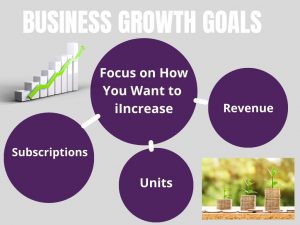Is growth the goal for your small business? If your answer is: “Of course!” that’s great, but you should also take a step back and think about the answers to some other questions. Questions like, “What does growth look like or mean for your business?” Or “What does success look like?” or “What is your plan for achieving your goals?” In short, having a vague goal for growth is not enough; you need to have more specific growth goals so that you can plan out things like your marketing strategy. There’s not much in life you would jump into without a plan – you wouldn’t even step up to a diving board without thinking through your next step! – so let’s look at what it means to plan ahead and have the right growth goal for your business. 
Picking a Growth Goal
One of the biggest mistakes small business owners make when they’re trying to grow? Not knowing what that growth means or what it should look like for their unique business. Without a clear growth strategy, you won’t know how to focus your efforts or measure your successes (or failures). Before you sit down and map out your business growth strategy, you need to actually pick your growth goal.
While revenue might be one of the most common growth goals, it’s not necessarily going to be the right goal for every business in every situation. Your growth goal should always align with what you’re generally trying to achieve as a business. Yes, that might mean profit margin, but it could also mean increasing your subscriber base or followers, impressing investors with exponential growth in your customer base, or getting a bump in brand recognition so you can spend less on marketing and use those funds for product innovation and service expansion.
Set your growth goals around one of the following:
- Revenue – Think: sales, net profit, total recurring revenue, average contract value, etc
- Subscriptions – Think: monthly recurring revenue, annual recurring revenue, etc
- Units – Think: total units sold/processed, customer base, new contracts, follower count, etc
Once you consider what you’re trying to grow, you’ll need think about:
- How much you want to increase it by – This can really vary based on your business and your goals. It’s easy to say, “We want to increase revenue by 20%,” but things can get a little more murky when you’re thinking beyond immediate profit. For example, how would you measure growing your customer base? If your goal is simply to build your customer base, ending with one more customer than you started with is technically a success, but is that the right goal for you? If you’re a freelance photographer, gaining one major client might be all you need. But, if you sell thousands of units of a product each day, acquiring one new customer will be almost meaningless.
- How you approach growing it – This can be tough, as well, because your approach might change over time, and you might switch back and forth between goals. After all, the unfortunate truth is that being laser-focused on one area of your business can mean other areas don’t perform as well – and you’ll need to be prepared to roll with those punches. For example, if you run a software-as-a-service (SaaS) business, you might want to increase your user base, so you might offer free trials or even free plans to reach that goal. But, with this strategy, you’ll get more users but not necessarily any more money. On the other hand, if you’re looking to specifically increase revenue, you can choose to switch to a premium service model to get free customers to start paying. You could make more money this way, but you could actually see your customer base decrease.
Getting Specific: Writing a Business Growth Strategy
Now that you’ve really thought about what it means for your specific business to grow, and what your unique successes would look like, you need to get specific in order to achieve your goals. That means creating a growth strategy, preferably in writing, so you can effectively (and with accountability) share it with others in your organization. Start with the following steps:

- Define Your Long- and Short-Term Goals – Now that you’ve thought about all of the above, the first step is to make a record of the goals you hope to achieve – say, in the next 5 years. Write them down to keep yourself on track! When considering increasing revenue, subscriptions, or units think about making goals like:
-
-
- Increase sales by 15%
- Grow organic site traffic by 35%
- Increase subscription trial conversion rate by 2%
- Add new product lines, expand into a new market, or open a second store
-
- Prioritize Your Goals – Once you’ve made a list of your goals, put them in order of importance, thinking about which ones:
-
- Are most vital to your business’ growth
- Offer the highest ROI
- Are achievable with your current resources
Remember, too, that some goals with need to be met in a certain order, while others
could be worked on at the same time.
- Figure Out Your Strategies for Meeting Your Goals – Now you need to take your goal and break down the steps you’ll need to go through to meet it. Let’s take a very concrete goal as an example: opening a new store in the next 6 months. You’ll need to take the following steps:
-
-
- Research a location
- Make sure your current revenue can support the initial costs
- Hire the necessary personnel and have a training strategy in place
- Start marketing a grand opening
-
- Check Out the Competition and Make Sure There’s Market Demand – Did you know that 42% of failed startups said that they failed because they overestimated market demand? Making assumptions could be devastating for your business, as could not adequately researching your competition. If you’re offering something new and innovative, it’s crucial to conduct market research to make sure there’s enough demand. If you’ve got a lot of competitors for your market, check them out thoroughly, asking questions like the following:

Focus on setting an attainable growth goal timeline.
-
-
- Who are your competitors and what exactly do they offer?
- What are their pricing models?
- What is their marketing strategy?
- What are their customers saying about them?
-
- Set Timelines – You need to make sure you have a set time period for achieving your highest priority goals, but you also need to know the sequence of achieving those top goals. For example, if your goal is to increase your user base by a certain amount in the next month, you might first need to work on the goal of launching a new service or create a new free trial offer to entice them.
While most small businesses are looking to grow, the specific goals and strategies for reaching those goals are going to be different for every business. It all boils down to really knowing your business and having a clear understanding of where you are and where you want to be in a specific amount of time. Doing your research, backing up your assumptions, and documenting your goals will take time and effort, but it’ll all pay off when you start reaching your growth goals!